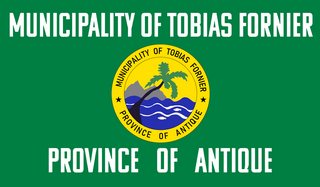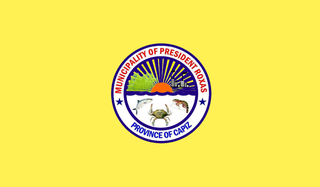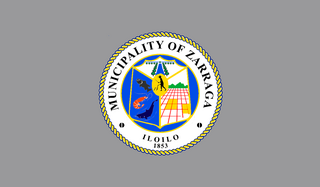
Pulupandan, officially the Municipality of Pulupandan, is a 3rd class municipality in the province of Negros Occidental, Philippines. According to the 2020 census, it has a population of 30,117 people.

Bugasong, officially the Municipality of Bugasong, is a 3rd class municipality in the province of Antique, Philippines. According to the 2020 census, it has a population of 34,676 people. Making it 8th most populous municipality in the province of Antique and fourth largest municipality in terms of land area, with a total area of 203.71 square kilometers.

Hamtic, officially the Municipality of Hamtic, is a 3rd class municipality in the province of Antique, Philippines. According to the 2020 census, it has a population of 52,685 people. Making it third most populous municipality in the province of Antique.

Patnongon, officially the Municipality of Patnongon, is a 3rd class municipality in the province of Antique, Philippines. According to the 2020 census, it has a population of 38,329 people.

Sebaste, officially the Municipality of Sebaste, is a 4th class municipality in the province of Antique, Philippines. According to the 2020 census, it has a population of 18,816 people. Making it 16th most populous municipality in the province of Antique.

Sibalom, officially the Municipality of Sibalom,, is a 2nd class municipality in the province of Antique, Philippines. According to the 2020 census, it has a population of 63,833 people. Making it second most populous municipality in the province of Antique and fifth largest municipality in terms of land area, with a total area of 201.30 square kilometers.

Tobias Fornier, officially the Municipality of Tobias Fornier,, is a 4th class municipality in the province of Antique, Philippines. According to the 2020 census, it has a population of 33,816 people, making it the ninth most populous municipality in the province of Antique.

Valderrama, officially the Municipality of Valderrama, is a 4th class municipality in the province of Antique, Philippines. According to the 2020 census, it has a population of 19,971 people. Making it 15th most populous municipality in the province of Antique and the second largest municipality in terms of land area, with a total area of 273.79 square kilometers.

Sierra Bullones, officially the Municipality of Sierra Bullones, is a third class municipality in the province of Bohol, Philippines. According to the 2020 census, it has a population of 26,095 people.

Sikatuna, officially the Municipality of Sikatuna, is a 5th class municipality in the province of Bohol, Philippines. According to the 2020 census, it has a population of 6,906 people.

President Roxas, officially the Municipality of President Roxas, is a 4th class municipality in the province of Capiz, Philippines. According to the 2020 census, it has a population of 31,269 people.

Caibiran, officially the Municipality of Caibiran, is a 5th class municipality in the province of Biliran, Philippines. According to the 2020 census, it has a population of 24,167 people. The town's populace predominantly speak Waray language.

Kawayan, officially the Municipality of Kawayan, is a 5th class municipality in the province of Biliran, Philippines. According to the 2020 census, it has a population of 20,455 people.

Arteche, officially the Municipality of Arteche, is a 3rd class municipality in the province of Eastern Samar, Philippines. According to the 2020 census, it has a population of 16,360 people.

San Policarpo, officially the Municipality of San Policarpo, is a 5th class municipality in the province of Eastern Samar, Philippines. According to the 2020 census, it has a population of 15,365 people.

Barotac Viejo, officially the Municipality of Barotac Viejo, is a 3rd class municipality in the province of Iloilo, Philippines. According to the 2020 census, it has a population of 48,614 people.

Batad, officially the Municipality of Batad, is a 5th class municipality in the province of Iloilo, Philippines. According to the 2020 census, it has a population of 22,157 people.

Zarraga, officially the Municipality of Zarraga, is a 4th class municipality in the province of Iloilo, Philippines. According to the 2020 census, it has a population of 27,305 people.

La Paz, officially the Municipality of La Paz, is a 5th class municipality in the province of Leyte, Philippines. According to the 2020 census, it has a population of 19,174 people.

Tabontabon, officially the Municipality of Tabontabon, is a 5th class municipality in the province of Leyte, Philippines. According to the 2020 census, it has a population of 11,902 people.


























